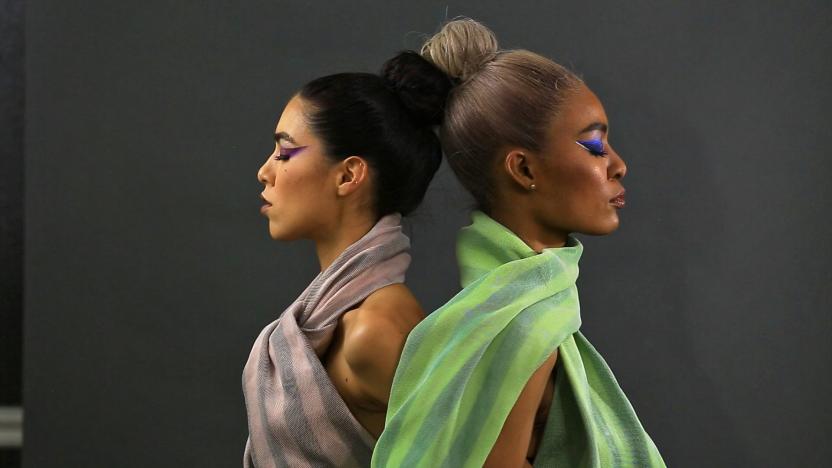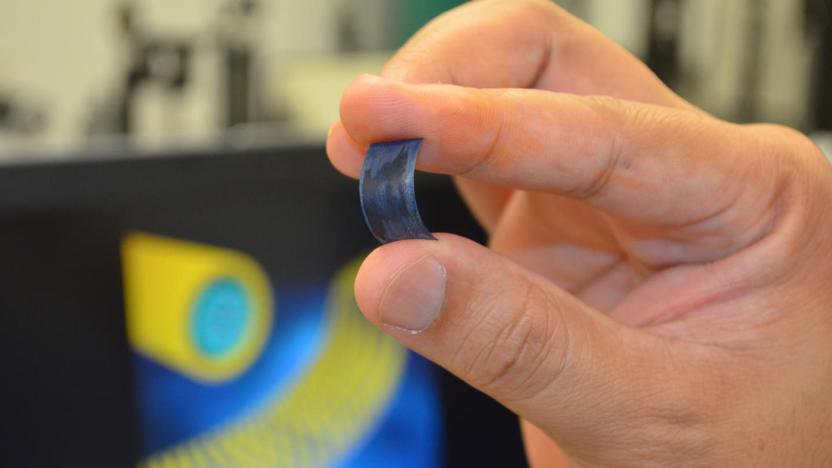UniversityOfCentralFlorida
Latest

Self-striping smart cloth is HyperColor for the 21st century
The debate over whether "the dress" is blue and black or white and gold now has a third answer: it can be both. At least it is when using a new color-changing fabric developed by a team from the College of Optics & Photonics (CREOL) at the University of Central Florida. This chameleon-like cloth is embedded with micro-wires that can shift the color of individual threads based on the amount of electrical current running through them.

New battery tech lasts for days, charges in seconds
Scientists from the University of Central Florida (UCF) have created a supercapacitor battery prototype that works like new even after being recharged 30,000 times. The research could yield high-capacity, ultra-fast-charging batteries that last over 20 times longer than a conventional lithium-ion cell. "You could charge your mobile phone in a few seconds and you wouldn't need to charge it again for over a week," says UCF postdoctoral associate Nitin Choudhary.

Nanotechnology can turn your jacket into a battery
There are certainly clothes and wires that can transmit electricity, but wouldn't it make sense if they could hold on to it as well? Researchers at the University of Central Florida certainly think so, since they've just developed technology that lets wires and threads store energy. Their approach sheathes the wire in nano-sized whiskers that, when treated, become electrodes; the sheath effectively becomes a supercapacitor that preserves energy without hurting electrical transmissions.

Researchers create spinal cord connectors from human stem cells, heralding breakthrough
It's taken many years and more than a bit of brainpower, but researchers at the University of Central Florida have finally found a way to create neuromuscular connectors between muscle and spinal cord cells, using only stem cells. Led by bioengineer James Hickman, the team pulled off the feat with help from Brown University Professor Emeritus Herman Vandenburgh, who collected muscle stem cell samples from adult volunteers. After close examination, they then discovered that under the right conditions, these samples could be combined with spinal cord cells to form connectors, or neuromuscular junctions, which the brain uses to control the body's muscles. UCF's engineers say the technique, described in the December issue of the journal Biomaterials, marks a major breakthrough for the development of "human-on-a-chip" models -- systems that simulate organ functions and have the potential to drastically accelerate medical research and drug development. These junctions could also pay dividends for research on Lou Gehrig's disease or spinal cord injuries, though it remains unclear whether we can expect to see these benefits anytime soon.

University of Central Florida's miniature laser diode aims to speed up networking
The use of laser as a means of data transmission is hardly anything new, but the current crop of laser diodes can only handle so much stress, provided that they don't fail in the first place. Luckily, the geniuses over at the University of Central Florida are about to deliver a smaller yet more intense and more reliable diode, which will lead to many more potential applications even beyond the scope of networking -- think cheaper, more effective hair removal. Little is said about how Professor Dennis Deppe's team made this possible, but once they work out how to optimize the operating voltage for better efficiency, Deppe reckons we'll see diode-embedded high speed, high bandwidth cables in the shops in four or five years' time. Seriously, we'd do anything to keep our latency low for some HD gaming action.

New carbon nanotube aerogel is now the world's lightest solid material
Frozen smoke (read: aerogel) -- not to be confused with the stuff your Grandma uses to flavor her turkey -- is the world's lightest solid material, and it just keeps getting lighter. Researchers at the University of Central Florida have created a new form of the super material, known as multi-walled carbon nanotube (MWCNT) aerogel, that has a density of just four milligrams per cubic centimeter and can be used in sensors to detect pollutants and toxic substances, chemical reactors, and electronic components. Aerogels, which are known as the world's most effective insulators, have been around since the early 20th century, but most of these are fabricated from silicon dioxide. In order to produce the new aerogel, researchers removed the liquid from a "wet gel of well-dispersed pristine MWCNTs," creating a honeycomb structure with walls just 100-nanometers thick. The resulting material is an impressive and resilient electrical conductor that looks and acts less like frozen smoke and more like a burnt marshmallow. And now, you know. Check out the coverage link below for video.

Motion capture game teaches tween girls to avoid the come-ons of boys from the Metaverse
The University of Central Florida has been awarded a $434k grant to develop a video game for tween girls. The game, which is still in development, is apparently designed to allow girls to "practice" rejecting peer pressure from boys for sex and make outs. Of course, the only natural way to immerse the player in such a game is to put her into a motion capture suit, where her jittery marionette of an avatar is surrounded by the most diabolical 3D models of teenage males obtainable on that $434k budget -- if it was paid to Neal Stephenson in 1992. "It's a place to practice where there aren't any social consequences," says Professor Anne Norris, who is heading the project. But who will protect them from the psychological consequences, Anne? And will there be any escape from the meta-virus? Check out the unintentionally hilarious video after the break.






